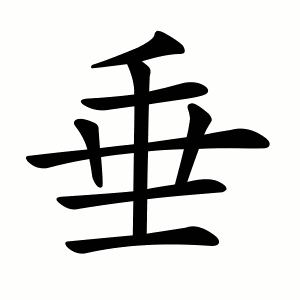垂
- to hang down, to let droop, to lower, to hand down;
Etymology
An ideograph: depicts plant leaves drooping down, representing the act of hanging or dangling.
Later meanings expanded metaphorically: “to hand down” (as in passing on teachings or legacy), and “about to happen” (imminent).
Usage in Korean
垂下 (수하) — to hang down
垂柳 (수류) — weeping willow (lit. “hanging willow”)
垂直 (수직) — vertical, perpendicular
垂老 (수로) — old age; in one’s declining years
垂訓 (수훈) — to hand down instruction
垂危 (수위) — on the verge of death; critically ill
Additional notes
Common in compound words for verticality (垂直) and metaphors of imminence (垂死 “about to die”).
Figuratively, 垂 often means “to bestow, to hand down” (垂恩 “to grant grace,” 垂愛 “to show favor”).
As a component, 垂 appears in characters like 睡 (sleep), 垣 (wall), and 螓 (forehead).
Alternative forms
Regional differences:
Mainland China: bottom horizontal stroke is written shorter than the one above; radical classified under 丿 (slash).
Taiwan: middle component 卄 is written with broken horizontal strokes, giving 9 total strokes.
- 竹十廿一 (HJTM)
- ⿻⿱ 千 工 艹
- ⿻⿱ 千 工 卄
